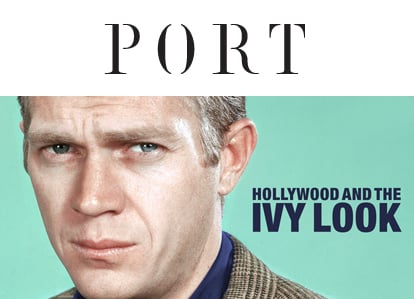Port
The Ivy League look of the fifties and sixties, headed by the likes of the ever-discerning Steve McQueen, redefined the sartorial characteristics of a generation of men. Betty Wood reviews Hollywood and The Ivy Look, a new pictorial collection which celebrates the golden era of quintessentially American style
From 1955 to the mid-60s, a new generation of film stars began appearing on the Silver Screen brandishing an understated confidence, anti-hero sensibilities and a quintessential air of coolness. This elite group, headed by Steve McQueen, Paul Newman and Anthony Perkins redefined what it meant to be a Hollywood leading-man, and just as importantly what it meant to look like one. Long-gone were the double-breasted three-piece suits and fedora hats of the Bogart era. This new generation of Hollywood’s hipsters appropriated the clothing style of America’s east-coast Ivy League institutions, in the process defining a quintessentially American style of clothing for a new generation of film-goers. This style captured on camera is presented here in Reel Art Press’ pictorial collection Hollywood and The Ivy Look by authors Tony Nourmand (The Rat Pack, Bill Gold: Poster Works) and Graham Marsh (East Coasting, The Cover Art of Blue Note Records).
The combination of brooding black and white imagery with bold colour portraits provides a cohesive yet playful aesthetic rhythm that mirrors the variety of the Ivy League style and its players – the preppy colourful wardrobes of Woody Allen and William Shatner juxtaposed with the muted natural fabrics (herring-bone tweed, corduroy and cotton) favoured by Montgomery Clift, McQueen and John Cassavetes.
Technically speaking, beyond the photography, Hollywood and the Ivy Look appears good. The typography and layout are clean and classic, with wide single columns, generous margins and offset captions. The use of 1950s magazine-style typefaces with their bold and oversized fonts replicates the graphic-preferences of the Ivy League era; an added detail is the use of full-page textile prints – seersucker, corduroy, tweed – to separate the sections of the book. This element of ‘usability’ corresponds with the final section of the book, ‘The Source’, which lists stockists, websites and brands that produce modern and vintage Ivy League style garments. Although not quite as exhaustive as the images at the fore of the book, nonetheless this section acts as a great platform for tentative shoppers to start from that goes beyond the usual demands of a coffee-table tome.
The casual (and brief style) of the written content provides more of a ‘taster’ than a definitive reference, although this is within the scope of the book’s function. Ultimately, Hollywood and The Ivy Look succeeds in whetting the appetite of interested readers, and is a sumptuous and lovingly collated visual collection that can be picked-up again and again.
To see full article online, with accompanying slideshow of images, click here.






